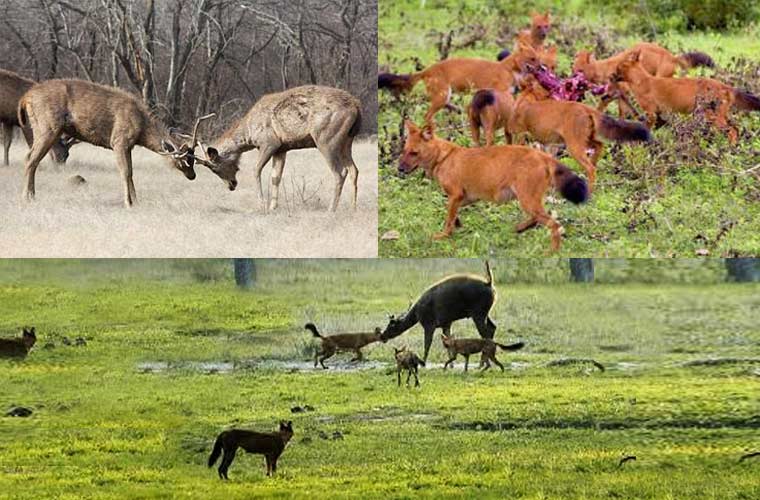Trending Now
- IPL 2024 begins with a bang. First contest between CSK and RCB.
- Election commission allots mike symbol to Naam Thamizhar Katchi
- AIADMK promises to urge for AIIMS in Coimbatore, in its election manifesto.
- Ponmudi becomes higher education minister.
Columns
It’s clash of united clans versus divided antlers
![]() June 29, 2017
June 29, 2017
Dholes appear most extreme of the canid given their unique morphological and behavioural traits, such as including specialised teeth for hypercarnivory , was how Jan. F. Kamler, the Southeast Asia Co-ordinator of Panthera Leopard Programme described these animals.
It was around 10.30 am on the way back from Mudumalai that this gruesome hunt began. A pack of 15-20 Asian wild dogs was hunting down a sambar just by the main road. On seeing our vehicle heading towards them the dholes, as the wild dogs are called, vanished into the bushes. The deer’s eye contact revealed a call for alms after its throat was slit open.
I desperately pleaded with my husband to rescue the helpless creature and his reply was it against sanctuary norms – the nature’s law of prey predator relationship. As we cleared the spot, the dholes returned to tear apart their victim. Rubbernecking the helpless creature’s stare I left the place with eyes wet and the victim’s last stare was haunting me the whole night.
The strength of the dog is the pack and the strength of the pack is the dog, is how those associated with wildlife describe the act.
Dholes or the Asian wild dogs (Cuon Alpinus) are canids that live and hunt in clans unlike the wolves that live and hunt in groups or packs. The strength of the clans varies from 12 to over 40 leading a communal life sans hierarchies. In tropical forests, the dholes compete with even tigers and leopards, targeting somewhat different prey species, but still with substantial dietary overlap.
The dhole attack is the most gruesome hunting in the world as larger carnivores first kill their prey by strangling their neck and then consume them. But these small canids attack their prey as a pack tearing them apart and eating them even when still alive!
It is an interesting fact that these creatures lead a closely knit family life, unlike their favourite prey sambars where the males live alone for much of the year, making it easy for them to be hunted down. While sparring male sambars lock their antlers like other deer which make both the rivals easy prey, when their antlers sometimes get interlocked.
The females live in small herds of up to 16 individuals. But mostly the average herd consists of only three or four individuals, typically consisting of an adult female, her most recent young and perhaps a subordinate, an immature female. This is an unusual pattern for deer, which more commonly live in larger groups. This is also a major reason for these vulnerable creatures to become easy targets for larger carnivores ranging from tigers, lions and leopards to smaller ones like dholes.
Unlike these ungulates, the cunning dogs lead a life of clans wherein the entire pack consists of both males and females with young ones, which is their true strength to hunt preys much bigger than they.
These diurnal hunters target ungulates huger and many times heavier than them, as their strength lies in the pack and not individual vigour.. The cunningness with which they target their prey is astounding. Once they spot the victim, they spread out on all sides to cover the prey from all sides. Typically they form a `V’ round the victim gradually engulfing it from rear side to front, making it impossible for the prey to escape.
More interesting is their social care for the pack as whole. Many a times these dogs happen to get severely wounded while hunting, mostly by the preys’breaking bones. But until the dog recovers fully, the entire clan takes care of the wounded one, meeting all its food necessities.
Though smaller in size, it is this unity that helps them challenge even larger carnivores like tigers or leopards. They are the best example for unity in strength.
But like any other wild animals, these packs are also diminishing along with the vanishing wilderness due to deforestation. These canids too have entered the endangered list with lack of habitats and prey consequently and poisoning in forest adjoining areas to prevent loss of domestic ungulates. The argument of animal activists is that little importance is given to the study or conservation of these canids, as most of them are busy with larger cats and least bothered about these smaller dogs that are needed to strike a balance of nature.
Disclaimer: The views expressed above are the author’s own.
(The author of the column is Uma Ram, freelance writer from Coimbatore)






















